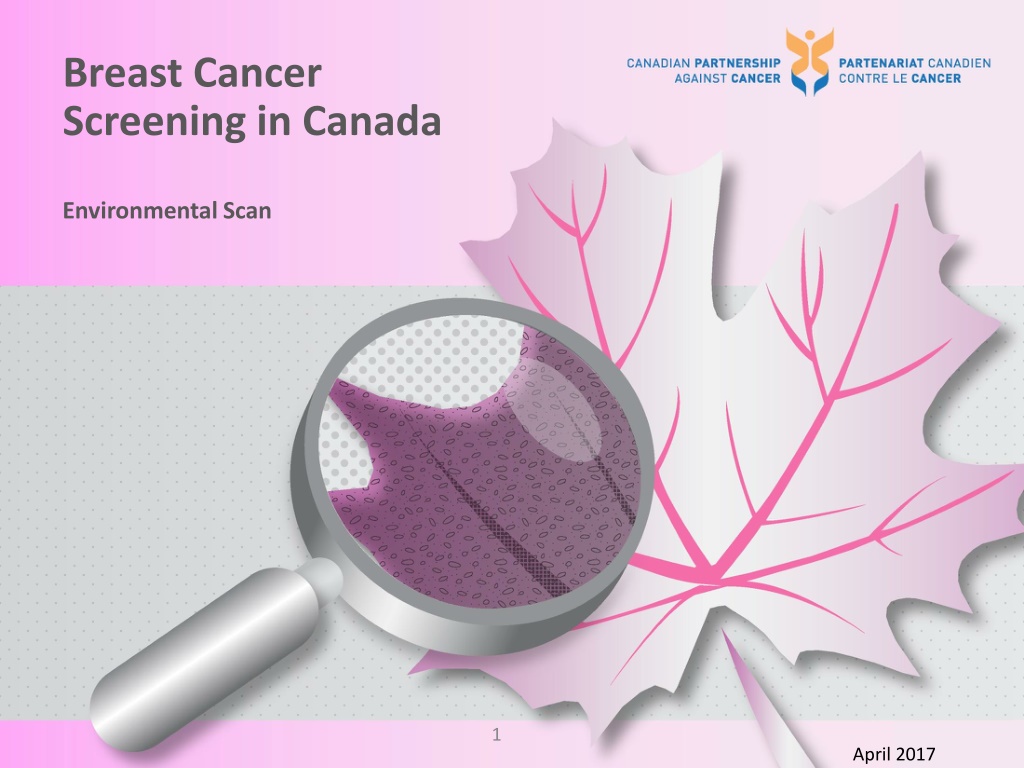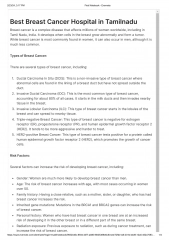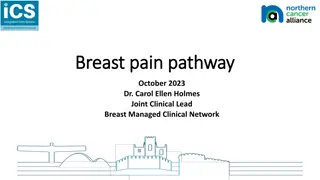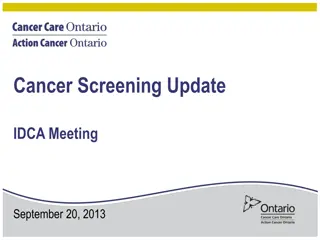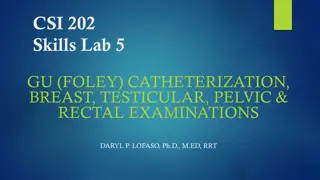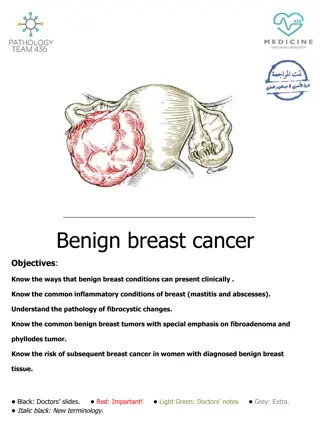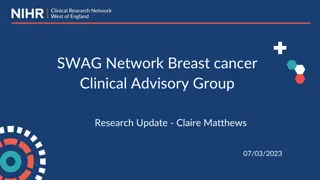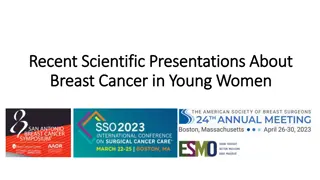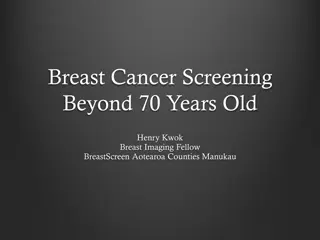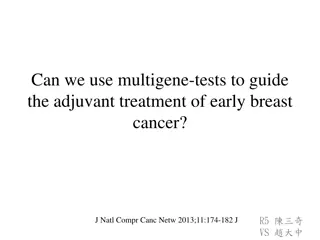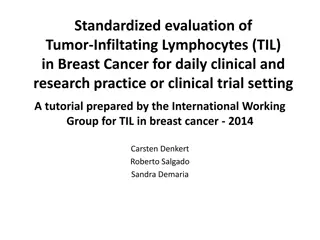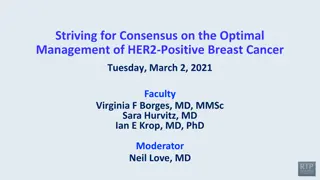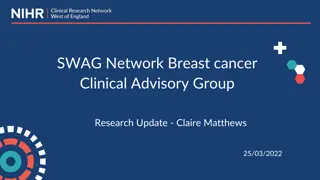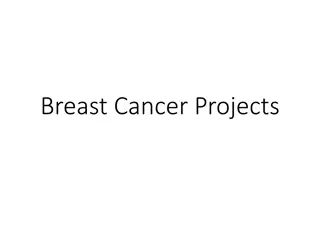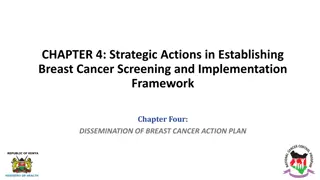Breast Cancer Screening Programs and Guidelines in Canada
Organized breast cancer screening programs are available in most provinces and territories in Canada for asymptomatic women at average risk. The screening guidelines recommend mammograms every two years for women aged 50 to 74 or 75, with variations in age acceptance and recruitment methods across regions. The first program started in British Columbia in 1988, with subsequent adoption by other provinces and territories. The aim is to provide information on policy and practice related to breast cancer screening in Canada.
Download Presentation

Please find below an Image/Link to download the presentation.
The content on the website is provided AS IS for your information and personal use only. It may not be sold, licensed, or shared on other websites without obtaining consent from the author. Download presentation by click this link. If you encounter any issues during the download, it is possible that the publisher has removed the file from their server.
E N D
Presentation Transcript
Breast Cancer Screening in Canada Environmental Scan 1 April 2017
Background The Canadian Partnership Against Cancer collects information annually on national, provincial and territorial breast cancer screening guidelines, strategies and activities. This scan summarizes the data collected from provincial and territorial screening programs and is intended to provide information on policy and practice. 2
Outline Breast Cancer Screening Programs and Guidelines Breast Cancer Screening Pathway Breast Cancer Screening Programs in Canada Canadian Task Force on Preventive Health Care Guidelines Provincial and Territorial Screening Guidelines Breast Cancer Screening Recruitment Methods Modalities for Breast Cancer Screening Correspondence Methods and Follow-Up for Breast Cancer Screening Breast Cancer Screening for Women at Elevated and High Risk 3
Breast Cancer Screening Programs and Guidelines Organized breast cancer screening programs are available in most provinces and territories across Canada. The programs screen women who are asymptomatic (no signs or symptoms of breast cancer present) and at average risk for breast cancer. Where organized screening programs are not available, screening services may be provided opportunistically through a primary care provider. 4
Breast Cancer Screening Programs and Guidelines Highlights Breast Cancer Screening Programs in Canada (refer to slide #7) The first organized breast cancer screening program began in British Columbia in 1988. From 1990 to 2008, 11 more provinces and territories started organized breast cancer screening programs. Nunavut does not have an organized breast cancer screening program. Provincial and Territorial Breast Cancer Screening Clinical Practice Guidelines (refer to slide #10-12) Most provinces and territories recommend screening women at average risk with a mammogram every two years at age 50, and continue until age 74 or 75. Some provinces and territories accept women at ages <50 to screen for breast cancer, every one or two years, if a woman chooses to get screened, has been identified as high risk, or has a physician recommendation. Breast Cancer Screening Recruitment Methods (refer to slide #13) Most provinces and territories (with the exception of Nunavut) recruit women into their breast cancer screening program with a physician referral or self-referral. Additionally, six provinces require an initial invitation letter to be accepted into the screening program. 5
Breast Cancer Screening Pathway Source: Canadian Partnership Against Cancer. Quality Determinants of Breast Cancer Screening with Mammography in Canada. Toronto: Canadian Partnership Against Cancer; February, 2013. 6
Breast Cancer Screening Programs in Canada Program start date Program name Agency responsible for program administration Nunavut* Northwest Territories 2003 Breast Screening Program, Stanton Territorial Health Authority Breast Screening Program, Hay River Health and Social Services Authority Stanton Territorial Health Authority 2008 Hay River Health and Social Services Authority Yukon 1990 Yukon Mammography Program Government of Yukon (Yukon Hospital Corporation) British Columbia 1988 BC Cancer Breast Screening BC Cancer Agency Alberta 1990 Alberta Breast Cancer Screening Program (ABCSP) Alberta Health Services Saskatchewan 1990 Screening Program for Breast Cancer Saskatchewan Cancer Agency Manitoba 1995 BreastCheck CancerCare Manitoba Ontario 1990 Ontario Breast Screening Program (OBSP) Cancer Care Ontario Programme qu b cois de d pistage du cancer du sein (PQDCS) Qu bec 1998 Minist re de la Sant et des Services sociaux New Brunswick 1995 New Brunswick Breast Cancer Screening Services New Brunswick Cancer Network (NB Department of Health) Nova Scotia 1991 Nova Scotia Breast Screening Program IWK Health Authority Prince Edward Island 1998 PEI Breast Screening Program Health PEI Newfoundland and Labrador 1996 Breast Screening Program for Newfoundland and Labrador Eastern Health, Cancer Care Program 7 *No organized screening program available in Nunavut
Canadian Task Force on Preventive Health Care Guidelines (2011) The Canadian Task Force on Preventive Health Care recommends screening women at average risk, aged 50-74, with mammography every 2-3 years. Average risk is defined as: No personal history of breast cancer No history of breast cancer in a first-degree relative No known mutations in BRCA1/2 genes No previous exposure of chest wall to radiation For more information please visit: http://canadiantaskforce.ca/ 8
Canadian Task Force on Preventive Health Care Guidelines (2011), cont d Additional breast cancer screening recommendations by the Canadian Task Force on Preventive Health Care (2011) include: Mammography Mammography screening for women aged 40-49 is not recommended for routine screening for breast cancer Magnetic Resonance Imaging Magnetic resonance imaging is not recommended for routine screening for breast cancer Clinical Breast Exam Clinical breast exam alone or in conjunction with mammography is not recommended for routine screening for breast cancer Breast Self Exam Breast self exam is not recommended for routine screening for breast cancer For more information please visit: http://canadiantaskforce.ca/ 9
Provincial and Territorial Breast Cancer Screening Clinical Practice Guidelines For asymptomatic women at average risk: Start age Interval Stop age Exclusion criteria Nunavut* Northwest Territories Begin at age 50 (age 40-49 accepted by physician referral for initial screen but not actively recruited) For women aged 40-49 - annual recall For women aged 50-74 - biennial recall 75 Personal history of breast cancer; no NWT healthcare coverage; no primary healthcare provider; acute symptoms; breast implants; breastfeeding in last 3 months Yukon Begin at age 50 (age 40-49 accepted by self-referral but not actively recruited) For women aged 50-74 - biennial recall 74 (age 75+ accepted by self referral, but not recalled) Previous breast cancer; breast implants; signs or symptoms of breast cancer British Columbia Begin at age 50 (age 40-49 accepted by self-referral but not actively recruited) For women aged 40-49 - biennial recall For women aged 50-74 - biennial recall 74 (age 75+ accepted by self referral but not actively recruited or recalled) Previous breast cancer; breast implants *No organized screening program available in Nunavut 10
Provincial and Territorial Breast Cancer Screening Clinical Practice Guidelines, cont d For asymptomatic women at average risk: Start age Interval Stop age Exclusion criteria Alberta Begin at age 50 (age 40-49 accepted with physician referral for the first screen) For women aged 40-49 - annual recall For women aged 50-74 - biennial recall 74 Women less than age 40; signs or symptoms of breast cancer; requiring follow-up with diagnostic imaging; requiring work-up for an unknown primary malignancy or possible metastatic disease to the breast or axilla; known diagnosis/history of breast cancer; men Saskatchewan Begin at age 50 (age 49 accepted to mobile unit if turning 50 in same calendar year) For women aged 50-74 - biennial recall 75+ Breast cancer in last 5 years; breast implants Manitoba Begin at 50 (ages 40- 49 accepted to mobile unit with physician referral) For women aged 40-49 - biennial recall For women aged 50-74 - biennial recall 74 (age 75+ accepted by self referral but not actively recruited or recalled) Previous breast cancer; breast implants; had a mammogram in the last 12 months Ontario Begin at age 50 For women aged 50-74 - biennial recall 74 (women 75+ can be screened but require a physician referral; not actively recruited or recalled by the OBSP) Acute breast symptoms; previous breast cancer; breast implants; mastectomy; had a mammogram in the last 11 months 11
Provincial and Territorial Breast Cancer Screening Clinical Practice Guidelines, cont d For asymptomatic women at average risk: Start age Interval Stop age Exclusion criteria (e.g. no previous breast cancer) Begin at age 50 (accept ages 35-49 only with physician referral, at a program designated screening or referral centre) For women aged 50-69 - biennial recall 69 (age 70+ only with a physician referral, at a program designated screening or referral centre) Previous breast cancer Qu bec New Brunswick Begin at age 50 (age 40-49 accepted only with physician or nurse practitioner referral) For women aged 50-74 - biennial recall 74 (age 74+ only with a physician or nurse practitioner referral) Previous breast cancer Nova Scotia Begin at age 50 (age 40-49 accepted by self- referral but not actively recruited) For women aged 40-49 - annual recall For women aged 50-69 - biennial recall 70+ Breast implants; previous breast cancer; signs or symptoms of breast cancer Prince Edward Island Begin at age 40 (accepted by self - referral) For women aged 40-49 - annual recall For women aged 50-74 - biennial recall 74 Previous breast cancer; had a mammogram in the last 12 months; breast implants Previous breast cancer; breast implants 74 (age 74+ only if previously enrolled in the program) Newfoundland and Labrador Begin at age 50 For women aged 50-74 - biennial recall This age group may change to 50-74; currently pending institutional approval 12
Breast Cancer Screening Recruitment Methods How are women recruited into your provincial/territorial breast cancer screening program? Target age group for recruitment Physician referral* Self- referral** Initial letter of invitation*** Other method of recruitment (please specify - e.g. phone call) Nunavut Northwest Territories ---- ---- 50-74 Yukon No ---- 50-74 British Columbia ---- ---- 50-69 Alberta Mobile announcement letter 50-74 Saskatchewan ---- 50-70+ Manitoba ---- 50-69 Nurse practitioners can refer women into the program Ontario 50-74 Qu bec ---- 50-69 (most Health Zones) New Brunswick Reminder phone calls offered at 1 Health Zone 50-74 Nova Scotia ---- ---- 50-69 Prince Edward Island ---- ---- 40-74 Newfoundland and Labrador ---- ---- 50-74 * Physician referral: physician refers participant into the breast cancer screening program ** Self-referral: an individual contacts the breast cancer screening program directly to participate in the program ***Initial letter of invitation: letters sent to women not currently enrolled in the screening program inviting them to schedule a screening test Target age group: the age group that is exclusively targeted by the program for invitation. This age group may be narrower than the age group eligible for screening based on the provincial/territorial guidelines No organized screening program available in Nunavut ---- No information was provided at the time the data was collected 13
Modalities for Breast Cancer Screening The modality commonly used as an entry level screening test for breast cancer is mammography. All provinces and territories (with the exception of Nunavut) perform mammography screening within organized screening programs. Currently, no province or territory recommends clinical breast examinations. Other modalities may include tomosynthesis or MRI, and their use may be dependent on a woman s risk level. 14
Modalities for Breast Cancer Screening Highlights Mammography Screening Technology (refer to slide #16-17) All provinces and territories (with the exception of Nunavut) are currently using digital radiography (DR) equipment to screen women in their programs. In addition, two provinces and one territory are using computed radiography (CR), as well as DR equipment. Only two provinces are using analog mammography (screen-films) in conjunction with DR and/or CR. Other Breast Cancer Screening Modalities (refer to slide #18-19) Other modalities used in Canada to screen women for breast cancer are tomosynthesis, magnetic resonance imaging (MRI) and ultrasound. Tomosynthesis is being used in four provinces (BC, AB, QC and NB). Ontario screens women at high risk for breast cancer using MRI or ultrasound through the Ontario Breast Screening High Risk Program. 15
Mammography Screening Technology Which mammography screening modalities are being used in your program? (please check all that apply) Analog mammography Digital mammography* Digital radiography (DR) Computed radiography (CR) Nunavut** Northwest Territories ---- Yukon No No British Columbia ---- Alberta No ---- Saskatchewan No ---- Manitoba No No Analog mammography: the mammography images are printed on film *Digital mammography: the mammography images are captured and manipulated electronically and includes, digital radiography (DR) and computed radiography (CR) systems **No organized screening program available in Nunavut ---- No information was provided at the time the data was collected 16
Mammography Screening Technology, contd Which mammography screening modalities are being used in your program? (please check all that apply) Analog mammography Digital mammography* Digital radiography (DR) Computed radiography (CR) Ontario No Qu bec No New Brunswick No Nova Scotia No ---- Prince Edward Island No ---- Newfoundland and Labrador ---- ---- Analog mammography: the mammography images are printed on film *Digital mammography: the mammography images are captured and manipulated electronically and includes, digital direct radiography (DR) and computer radiography (CR) systems ---- No information was provided at the time the data was collected 17
Other Breast Cancer Screening Modalities What other screening modalities (e.g. tomosynthesis, MRI) are being used in your program? (please check all that apply) Tomosynthesis (please specify e.g. 2D or 3D)* Other (please specify) Level of risk for use of modality [e.g. average, elevated (breast density), high (BRCA)] Additional comments Nunavut** Northwest Territories No No N/A ---- Yukon No No N/A ---- (Both 2D and 3D) British Columbia ---- ---- Only offered at 2 centers to clients who are participating in a tomosynthesis randomized control trial. (Both 2D and synthetic view and 3D at many sites) Alberta ---- Tomosynthesis pilot study at AHS Screen Test (for women with elevated risk >25% breast density) Clinics with tomosynthesis technology offer it to appropriate clients as determined by radiologists; AHS Screen Test clients at fixed sites are in a pilot study; tomosynthesis data is captured at site level and process is underway to import data into ABCSP database. Saskatchewan No No N/A ---- Manitoba No No N/A ---- *Tomosynthesis (also known as 2D or 3D mammography) is an emerging technology that allows the breast to be viewed three-dimensionally **No organized screening program available in Nunavut ---- No information was provided at the time the data was collected N/A = Not applicable 18
Other Breast Cancer Screening Modalities, contd What other screening modalities (e.g. tomosynthesis, MRI) are being used in your program? (please check all that apply) Tomosynthesis (please specify e.g. 2D or 3D) Other (please specify) Level of risk for use of modality [e.g. average, elevated (breast density), high (BRCA)] Additional comments Ontario No MRI, MRI or ultrasound (if MRI is contraindicated) for women considered high risk Women ages 30 to 69 who are at high risk of getting breast cancer are screened once a year with a mammogram and MRI (or if MRI is not appropriate, screening breast ultrasound). ultrasound (i.e. High Risk OBSP) No N/A An evaluation by the Institut national d excellence en sant et services sociaux expert group on the use of tomosynthesis is underway. Qu bec New Brunswick No N/A Clinics offer tomosynthesis and MRI technology to appropriate clients (as determined by radiologists) but this is part of the Diagnostic Mammograghy Program and not the Screening Program. Nova Scotia No No N/A Tomosynthesis and MRI are not utilized in screening centres and there is limited availability in some diagnostic breast imaging sites. Prince Edward Island No No N/A ---- Newfoundland and Labrador No No N/A ---- Tomosynthesis (also known as 2D or 3D mammography) is an emerging technology that allows the breast to be viewed three-dimensionally ---- No information was provided at the time the data was collected N/A = Not applicable 19
Correspondence Methods and Follow- Up for Breast Cancer Screening Recall letters or other forms of communication are used to notify women who have been screened by the program in the past to return for screening. Women who have a normal screening result are invited back at regular intervals (as per provincial/territorial screening guidelines) for subsequent screening. Women who have an abnormal screening result are invited for follow-up. 20
Correspondence Methods and Follow-Up for Breast Cancer Screening Highlights Recall Following a Normal Mammogram (refer to slide #23-24) All provinces and territories (with the exception of Nunavut) send out recall letters or a postcard to women after they obtain a normal mammography result. In addition, a follow-up letter is sent if there has been no reply to the initial recall letter (excludes Nunavut and Yukon). Most provinces and territories send out reminder notifications via letter if no response was received after the first communication. The target age group for recall of a normal result varies across Canada where the majority of the provinces target women ages 40-74 (four provinces and one territory) and ages 50-74 (five provinces). 21
Correspondence Methods and Follow-Up for Breast Cancer Screening Highlights, cont d Follow-Up After an Abnormal Mammogram (refer to slide #25-28) All provinces and territories (with the exception of Nunavut) send recall letters to both the primary care provider and women after an abnormal (positive) mammography result is obtained. Some provinces and territories contact women by phone for informing them about their result and/or booking a follow-up appointment. In the absence of a primary care provider, seven provinces help women find a suitable primary care provider in order to be followed-up after an abnormal mammography result. NWT, YK and BC require a primary care provider prior to being eligible for a screening mammogram. In PEI, either the provincial coordinator or Medical Director/Surgeon directly call women with the abnormal mammography result. When a woman cannot be reached (e.g. return mail), most provinces and territories contact and notify the primary health care provider or obtain current contact information from the primary health care provider; furthermore, some provinces and territories try to contact the woman by telephone or letter; two provinces check for an alternate source to locate a recent address. The location for conducting diagnostic mammograms after an abnormal result vary across Canada. Five provinces and one territory performs diagnostic mammograms at Diagnostic Breast Imaging Centres. Five provinces and one territory performs such mammograms at the screening centre/program and four provinces refer women to Breast or Risk Assessment units. 22
Recall Following a Normal Mammogram How are women being recalled for routine breast cancer screening at the program-recommended interval? Notification methods used (e.g. letter, phone, email) Notification sent to (e.g. woman, primary care provider, both) Reminder notification sent if no response to first communication Who coordinates the recall for women following a normal screening episode (e.g. Program or Centre)? Age group for recall Nunavut* Yes (2nd letter sent 6 weeks after 1st) Northwest Territories Letter Woman Regional Coordination Centres 41-74 Yukon Letter Woman No Screening Centre 40-74 (40-49 with radiologist recommendation) British Columbia Postcard Woman Yes (a total of 4 reminders sent over a 12 month period) Centralized Management (Program or Agency) 40-74 Alberta Letter Woman No Centralized Management (Program or Agency) 40-74 Saskatchewan Letter Woman Yes (reminder letter sent 2 weeks prior to mammography date if no appointment is scheduled) Centralized Management (Program or Agency) 50-74 Yes (2nd letter 3 weeks after 1st) Manitoba Letter Woman Centralized Management (Program or Agency) 50-74 *No organized screening program available in Nunavut 23
Recall Following a Normal Mammogram, contd How are women being recalled for routine breast cancer screening at the program-recommended interval? Notification methods used (e.g. letter, phone, email) Notification sent to (e.g. woman, primary care provider, both) Reminder notification sent if no response to first communication Who coordinates the recall for women following a normal screening episode (e.g. Program or Centre)? Age group for recall Ontario Letter Woman Yes (reminder letter sent 10 weeks after the recall letter if the woman has not yet been screened) Centralized Management (Program or Agency) 50-74 Letter Woman Yes (reminder letter is sent) Regional coordination centers 50-69 Qu bec New Brunswick Letter or Phone Woman (most Health Zones) N/A Regional Health Authorities at the Zone Level 50-74 Nova Scotia Postcard Woman Yes (3 reminder letter attempts are made in 3 consecutive years) Centralized Management (Program or Agency) 40--69 Prince Edward Island Letter Woman Yes (reminder sent after 1 month if no response received) PEI Breast Screening Program 40-74 Newfoundland and Labrador Letter Woman No Centralized Management (Program or Agency) 50-74 N/A = Not applicable 24
Follow-Up After an Abnormal Mammogram How are women notified of an abnormal test result and where is follow-up performed? Abnormal test result is communicated by: Sending a letter to both the primary care provider (PCP) and woman What is the process for result notification and follow-up when women do not have a PCP? What is the process for result notification when women cannot be reached (e.g. return mail)? Where is the diagnostic mammogram performed after an abnormal result a) Screening program b) Assessment unit c) Other (please specify) Other method used (e.g. phone, email) and to whom is it directed to Nunavut* (Women are contacted by phone to confirm availability of follow-up appointment time(s)) Northwest Territories All women name PCP before a screening mammogram can be done; therefore, all results can be sent to the indicated PCP The women are contacted by phone to inform them they need to return for further imaging and to confirm their availability for a follow-up appointment. Then the letter is sent with the appointment date as a reminder. If this fails, then case is closed as a Lost to Follow-up a) Screening Centre which is also a Diagnostic Centre (Women contacted, by phone (if further imaging required)) Yukon Women must have a PCP in order to be eligible for screening Follow-up with PCP if unable to contact woman a) Same site as screening (only single site/unit in Yukon) British Columbia ---- Women must have a PCP in order to be eligible for screening Follow up with PCP if unable to contact woman c) Affiliated diagnostic imaging center *No organized screening program available in Nunavut 25
Follow-Up After an Abnormal Mammogram, cont d How are women notified of an abnormal test result and where is follow-up performed? Abnormal test result is communicated by: What is the process for result notification and follow-up when women do not have a PCP? What is the process for result notification when women cannot be reached (e.g. return mail)? Where is the diagnostic mammogram performed after an abnormal result a) Screening program b) Assessment unit c) Other (please specify) Sending a letter to both the primary care provider (PCP) and woman Other method used (e.g. phone, email) and to whom is it directed to (Women are informed by letter; PCP are informed by radiologist s report) (Some women in community clinics are informed on site by radiologist) Alberta Clinics will assist with finding PCP Check alternate source for address, if more recent address found then resend; follow-up through PCP a) Majority are completed at community clinics that are part of the Screening program b) Some are completed at Risk Assessment units c) Some are completed at hospital facilities that perform diagnostic mammography (Client navigator calls women before letter is sent) Saskatchewan Client navigator works with women to obtain PCP Contact PCP for current phone number c) Diagnostic units in Breast Centers across Regina or Saskatoon (Women contacted by phone) Manitoba Work with women to obtain PCP*; reminder sent out if no response Attempt to contact woman if contact information is updated by Manitoba Health; attempt to find contact information by contacting PCP office c) Diagnostic Breast Imaging centers (hospitals, private radiology clinics, and/or Breast Health Center) *CancerCare Manitoba - BreastCheck works with Manitoba Health Doctor Finder Program to find PCP; also have arrangements with Breast Health Center for some of their physicians to take on the care of the patient in those cases; or Medical Lead at BreastCheck will take on temporary care of patient so follow-up can be performed while PCP is being arranged. 26
Follow-Up After an Abnormal Mammogram, cont d How are women notified of an abnormal test result and where is follow-up performed? Abnormal test result is communicated by: What is the process for result notification and follow-up when women do not have a PCP? What is the process for result notification when women cannot be reached (e.g. return mail)? Where is the diagnostic mammogram performed after an abnormal result a) Screening program b) Assessment unit c) Other (please specify) Sending a letter to both the primary care provider (PCP) and woman Other method used (e.g. phone, email) and to whom is it directed to (Women informed by sites through phone call, letter; and primary care through radiologist s report (e.g. by site, radiologist s report)) Ontario ---- A physician designate at the Ontario Breast Screening Program site manages an abnormal result The OBSP site will follow up with the PCP. The site may call or send a letter to the woman requesting that she follow-up with the OBSP site a) Screening program b) Breast assessment sites a) Accredited screening program or b) Assessment unit [Women contacted by phone (by Assessment Unit)] Voluntary regional PCP database: a voluntary PCP is assigned the day of the mammography visit Letter sent to woman by mail recommended to be sent by 90 days after mammography Qu bec (Letter or reports sent to PCPs; and some Zones send letters to women) (Women contacted by phone and faxes are sent to some providers (in certain Zones)) New Brunswick No consistent process followed across the Zones No consistent process followed across the Zones c) Outside of the Screening Program; site of investigation varies across Zones ---- No information was provided at the time the data was collected 27
Follow-Up After an Abnormal Mammogram, cont d How are women notified of an abnormal test result and where is follow-up performed? Abnormal test result is communicated by: What is the process for result notification and follow-up when women do not have a PCP? What is the process for result notification when women cannot be reached (e.g. return mail)? Where is the diagnostic mammogram performed after an abnormal result a) Screening program b) Assessment unit c) Other (please specify) Sending a letter to both the primary care provider (PCP) and woman Other method used (e.g. phone, email) and to whom is it directed to Nova Scotia No Work with the woman and the site to find a PCP (physician or a nurse practitioner) that will accept the abnormal report Contact the PCP (if the woman has one) or call by phone c) Diagnostic breast imaging site Prince Edward Island No Phone call from Provincial Coordinator/on-call Medical Director/Surgeon PCP is contacted c) Provincial Diagnostic Imaging Services (same location as screening program) Newfoundland and Labrador No Program will provide assistance to women to find PCP Check alternate source for address, if more recent address found then resend. Otherwise follow- up through PCP b) Assessment unit 28
Breast Cancer Screening in Canada for Women at Elevated Risk Women at elevated risk are individuals who are not considered average risk or high risk. This may include women who have a family history of breast cancer, have high breast density, used hormone replacement therapy in the past and/or are at high risk for benign breast disease. This differs from women at high risk who have a greater lifetime risk of developing breast cancer and/or developing more aggressive breast cancers at an earlier age. 29
Breast Cancer Screening in Canada for Women at Elevated Risk Highlights Definition of Elevated Risk (refer to slide #31-32) Two provincial and one territorial screening programs define elevated risk as having first-degree family history of breast cancer, using hormone replacement therapy, having a breast density of 75% or 75%, having a history of high risk benign breast disease and having a recommendation by a radiologist. Some provincial/territorial programs only have one to four of these characteristics listed to define elevated risk. There are other characteristics that are also listed by some provincial/territorial programs and include: having personal or first-degree family history of ovarian cancer (NWT, MB, ON), Ashkenazi ancestry with any family history (MB) and first or second-degree family history of male breast cancer (MB). Management of Elevated Risk by Screening Program (refer to slide #33-34) There are seven provincial and one territorial screening programs (with the exception of Nunavut) that screen women at elevated risk. The screening protocol most commonly recommended to women at elevated risk is a mammogram every year. Across Canada, the age group to start and stop screening women at elevated risk varies where the age groups are 40-74 (two provinces/one territory), 50-74 (three provinces), 69-74 (one province) and 40+ (one province). For the provincial/territorial programs that do not directly manage women at elevated risk, the follow-up strategies differ. Referral for Elevated Risk (refer to slide #35-36) There are six provinces and one territory that manages women at elevated risk through their screening programs. For the provinces that do not manage women within their programs, they refer women to: their family physician (AB, QC, NB), a surveillance program (AB, PEI) or a diagnostic centre (NB). 30
Definition of Elevated Risk* Within your program, which characteristics, based on a participant s screening history, might put her at elevated' risk of breast cancer? (check all that apply) First-degree family history Hormone replacement therapy use Breast density > 75% or 75% History of high risk benign breast disease Radiologist recommendation Other (please specify) Nunavut** Personal history or 1st degree family history of ovarian cancer Northwest Territories Yukon ---- ---- ---- ---- ---- British Columbia ---- ---- ---- ---- ---- Alberta ---- ---- ---- ---- Currently not defined in Alberta s Toward Optimized Practice - Clinical Practice Guideline; and being reviewed by the program Saskatchewan ---- ---- Manitoba 1st or 2nd degree family history of ovarian cancer; age at diagnosis; Ashkenazi ancestry with any family history ---- ---- *Elevated risk = women who are not considered average risk or high risk **No organized screening program available in Nunavut In Manitoba, this definition includes women at low risk (12-24% lifetime risk) and is based on the Claus Model, which takes into consideration the number of first or second degree blood relatives (male and female) diagnosed with breast cancer and/or ovarian cancer, as well as the factors listed in the other category ---- No information was provided at the time the data was collected 31
Definition of Elevated Risk* Within your program, which characteristics, based on a participant s screening history, might put her at elevated' risk of breast cancer? (check all that apply) First-degree family history Hormone replacement therapy use Breast density > 75% or 75% History of high risk benign breast disease Radiologist recommendation Other (please specify) Ontario ---- Personal history or first-degree family history of ovarian cancer Qu bec ---- ---- ---- ---- ---- New Brunswick N/A N/A N/A N/A N/A Currently not defined and under review by the program (radiologist recommendation is based on the four categories listed to the left) ---- Nova Scotia Prince Edward Island ---- Newfoundland and Labrador ---- ---- ---- *Elevated risk = women who are not considered average risk or high risk ---- No information was provided at the time the data was collected N/A= Not applicable 32
Management of Elevated Risk* by Screening Program How does your program manage women who are identified at elevated risk? Does your program manage women who are identified at elevated risk* (yes; no) If yes, what is the screening protocol administered by the program Additional information Screening modality used (e.g. mammography) Interval (e.g. annual) Start and stop age Nunavut** Northwest Territories Yes Mammography Annual 40-74 ---- Yukon No N/A N/A N/A Program collects information on family history, HRT use, and history of benign breast disease at time of screening. Program then follows radiologist recommendation for recall interval British Columbia Yes Mammography Annual 40-74 Routine annual screening for women with first-degree family history Alberta No N/A N/A N/A Not currently identified by program. If identified by family physician, may refer to high risk clinics; if not identified, included in current program as assumed average risk Saskatchewan Yes Mammography Annual 69-74 Program will complete mammogram for women with: family history, breast density over 75%, ADH, LCIS - if radiologist requests mammogram in one year *Elevated risk = women who are not considered average risk or high risk **No organized screening program available in Nunavut ---- No information was provided at the time the data was collected N/A = Not applicable 33
Management of Elevated Risk* by Screening Program, cont d How does your program manage women who are identified at elevated risk? Does your program manage women who are identified at elevated risk (Yes; No) (e.g. annual) If yes, what is the screening protocol administered by the program Additional information Screening modality used Interval Start and stop age Manitoba Yes Mammography Annual (for some cases) 50-74 Women ages 40-49 accepted to mobile unit with physician referral; age 75+ accepted by self-referral but not actively recruited or recalled Yes Mammography Annual 50-74 Women may be recalled annually (up to age 74) if they meet one of the following criteria: high-risk pathology lesions; family history Ontario No N/A N/A N/A Women with a personal history of breast cancer or ductal carcinoma in situ (DCIS) are excluded from the screening program Qu bec New Brunswick No N/A N/A N/A ---- Nova Scotia Yes Mammography Annual 40+ After age 69, women are not sent a reminder postcard to book their next screen, but are accepted into the program if they choose to continue screening Prince Edward Island Yes Mammography Annual 40- 74 Women with a first-degree relative with breast cancer can enter the screening program 10 years prior to when the cancer was detected Newfoundland and Labrador Yes Mammography Annual 50-74 Start/stop age is variable depending upon condition for elevated risk designation (e.g. breast density 75% may be a transitory condition therefore, start/stop age would be adjusted) *Elevated risk = women who are not considered average risk or high risk ---- No information was provided at the time the data was collected N/A = Not applicable 34
Referral for Elevated Risk* Where are women referred when they have been identified as elevated risk? Managed by screening program OR referred to: Surveillance program Diagnostic centre Referral back to primary physician Other (please specify) Nunavut** Northwest Territories N/A N/A N/A N/A Yukon No N/A N/A N/A Currently no specific definition of elevated risk in program policies British Columbia ---- ---- ---- ---- (managed by high risk clinics) (as determined by high risk clinics) Alberta No ---- Not currently identified by program. If identified by family physician, may refer to high risk clinics; if not identified, included in current program as assumed average risk Saskatchewan No N/A N/A N/A N/A Manitoba N/A N/A N/A N/A *Elevated risk = women who are not considered average risk or high risk **No organized screening program available in Nunavut ---- No information was provided at the time the data was collected N/A = Not applicable 35
Referral for Elevated Risk*, contd Where are women referred when they have been identified as elevated risk? (check all that apply) Managed by screening program OR referred to: Surveillance program Diagnostic centre Referral back to primary physician Other (please specify) Ontario N/A N/A N/A N/A No ---- ---- ---- Qu bec New Brunswick No N/A N/A ** Nova Scotia N/A N/A N/A N/A Prince Edward Island ---- ---- ---- Newfoundland and Labrador ---- ---- ---- ---- *Elevated risk = women who are not considered average risk or high risk **This pertains to women over the age of 40; women who are younger than 40 are imaged in a diagnostic centre but managed by the screening program ---- No information was provided at the time the data was collected N/A = Not applicable 36
Breast Cancer Screening in Canada for Women at High Risk Women at high risk have a greater lifetime risk of developing breast cancer and/or developing more aggressive breast cancers at an earlier age. Currently, there are no national guidelines for screening women at high risk and screening protocols vary across jurisdictions. 37
Breast Cancer Screening in Canada for Women at High Risk Highlights Definition of High Risk (refer to slide #39-42) The Ontario Breast Screening Program (OBSP) screens women at high risk through their high risk screening program by meeting the following eligibility criteria: known carriers of a deleterious gene mutation (e.g. BRCA 1/2 mutation), first-degree relative of a mutation carrier (e.g. BRCA 1/2 mutation) and have declined genetic testing, at 25% lifetime risk of breast cancer (must be assessed by using IBIS or BOADICEA risk assessment tools) and received chest radiation before the age of 30 and at least eight years previously. Five provinces include the same characteristics listed in the OBSP high risk eligibility criteria. Four provinces include two or three out of the four characteristics to define women at high risk. Management of High Risk by Screening Program (refer to slide #43-44) Six provincial screening programs screen women identified at high risk by recommending mammography screening every year (BC, MB, NS, PEI, ON) or every two years (QC). Depending on the province, guidelines recommend that women at high risk start screening at age 30, 40 or 50 and continue screening until age 69 or 74. In Ontario, women at high risk are also screened annually with MRI (or ultrasound if MRI is contraindicated). 38
Definition of High Risk* Within your program, what characteristics of a woman or screening history might put her at high risk of breast cancer? (check all that apply) Known carriers of a deleterious gene mutation (e.g. BRCA1, BRCA2)** First-degree relative of a mutation carrier (e.g. BRCA1, BRCA2) and have declined genetic testing** At >=25% lifetime risk of breast cancer (assessed using IBIS or BOADICEA risk assessment tools)** Received chest radiation before age 30 and at least 8 years previously** Other (please specify) Source of definition [e.g. clinical practice guideline (CPG)] Nunavut Northwest Territories ---- ---- ---- ---- ---- Guidelines currently under review Yukon N/A N/A N/A N/A N/A ---- British Columbia ---- ---- CPG *High risk = women who are at a greater lifetime risk of developing breast cancer and/or developing more aggressive breast cancers at an earlier age **High risk eligibility criteria obtained from the Ontario Breast Screening Program Category A - High Risk Screening (Cancer Care Ontario, 2011) for more information visit https://www.cancercare.on.ca/pcs/screening/breastscreening/OBSP/highrisk/ No organized screening program available in Nunavut Currently no specific definition of high risk in program policies ---- No information was provided at the time the data was collected N/A = Not applicable 39
Definition of High Risk*, contd Within your program, what characteristics of a woman or screening history might put her at high risk of breast cancer? (check all that apply) Known carriers of a deleterious gene mutation (e.g. BRCA1, BRCA2)** First-degree relative of a mutation carrier (e.g. BRCA1, BRCA2) and have declined genetic testing** At >=25% lifetime risk of breast cancer (assessed using IBIS or BOADICEA risk assessment tools)** Received chest radiation before age 30 and at least 8 years previously** Other (please specify) Source of definition [e.g. clinical practice guideline (CPG)] Alberta Screening Clinical Practice Guideline also includes the following which may be equivalent to elevated in other regions: Breast biopsy showing atypical hyperplasia or lobular carcinoma in situ (LCIS) and following surgical management to rule out invasive carcinoma One or two first-degree relatives with invasive breast cancer, but do not meet the criteria for referral to Medical Genetics Alberta s Toward Optimized Practice - CPG (assessment tool not specified in policy/guideline) (annual mammogram and MRI starting 5-10 years after radiation given; no later than age 40) Saskatchewan Abnormal mammograms, diagnostic centres, Breast density, atypical ductal hyperplasia, LCIS; physician request or radiologist request ---- *High risk = women who are at a greater lifetime risk of developing breast cancer and/or developing more aggressive breast cancers at an earlier age **High risk eligibility criteria obtained from the Ontario Breast Screening Program Category A - High Risk Screening (Cancer Care Ontario, 2011) for more information visit https://www.cancercare.on.ca/pcs/screening/breastscreening/OBSP/highrisk/ ---- No information was provided at the time the data was collected 40
Definition of High Risk*, contd Within your program, what characteristics of a woman or screening history might put her at high risk of breast cancer? (check all that apply) Known carriers of a deleterious gene mutation (e.g. BRCA1, BRCA2)** First-degree relative of a mutation carrier (e.g. BRCA1, BRCA2) and have declined genetic testing** At >=25% lifetime risk of breast cancer (assessed using IBIS or BOADICEA risk assessment tools)** Received chest radiation before age 30 and at least 8 years previously** Other (please specify) Source of definition [e.g. clinical practice guideline (CPG)] Manitoba --- --- Ashkenazi ancestry with any family history; History of high risk benign breast disease; Radiologist recommendation ---- (based on Claus model) Ontario Other eligibility criteria for the High Risk OBSP: ages 30-69; have no acute breast symptoms Cancer Care Ontario Program in Evidence-Based Care (PEBC) *High risk = women who are at a greater lifetime risk of developing breast cancer and/or developing more aggressive breast cancers at an earlier age **High risk eligibility criteria obtained from the Ontario Breast Screening Program Category A - High Risk Screening (Cancer Care Ontario, 2011) for more information visit https://www.cancercare.on.ca/pcs/screening/breastscreening/OBSP/highrisk/ In Manitoba, this definition includes women at high risk ( 25% lifetime risk) and is based on the Claus Model, which takes into consideration the number of first or second degree blood relatives (male and female) diagnosed with breast cancer and/or ovarian cancer, and the age at which they were diagnosed, as well as the factors listed in the other category ---- No information was provided at the time the data was collected N/A = Not applicable 41
Definition of High Risk*, contd Within your program, what characteristics of a woman or screening history might put her at high risk of breast cancer? (check all that apply) Known carriers of a deleterious gene mutation (e.g. BRCA1, BRCA2)** First-degree relative of a mutation carrier (e.g. BRCA1, BRCA2) and have declined genetic testing** At >=25% lifetime risk of breast cancer (assessed using IBIS or BOADICEA risk assessment tools)** Received chest radiation before age 30 and at least 8 years previously** Other (please specify) Source of definition [e.g. clinical practice guideline (CPG)] Qu bec N/A The Institut national d excellence en sant et services sociaux is developing recommendations New Brunswick N/A N/A N/A N/A N/A Currently no specific definition of high risk; program policies under review Nova Scotia N/A In the process of developing a CPG Prince Edward Island ---- ---- ---- Newfoundland and Labrador ---- ---- CPG *High risk = women who are at a greater lifetime risk of developing breast cancer and/or developing more aggressive breast cancers at an earlier age **High risk eligibility criteria obtained from the Ontario Breast Screening Program Category A - High Risk Screening (Cancer Care Ontario, 2011) for more information visit https://www.cancercare.on.ca/pcs/screening/breastscreening/OBSP/highrisk/ All of the categories are considered for high risk; however, there is no standard definition or provincial recommendation for high risk women to pursue MRI ---- No information was provided at the time the data was collected N/A = Not applicable 42
Management of High Risk* by Screening Program How does your program manage women who are identified as high risk? (check all that apply) Does your program screen women who are identified at high risk (Yes; No) If yes, what is the screening protocol administered by the program Additional information Screening modality used (e.g. MRI) Interval (e.g. annual) Start and stop age Nunavut** Northwest Territories ---- ---- ---- ---- Guidelines currently under review Yukon No N/A N/A N/A No current program policies for high risk British Columbia Yes Mammography Annual 40-74 Women under age 40 are accepted with a physician referral Annual breast MRI is available outside the screening program by physician referral for women with BRCA1/2 gene mutations or very strong family history of breast cancer Alberta No N/A N/A N/A ---- Saskatchewan No N/A N/A N/A ---- Manitoba Yes Mammography Annual 50-74 Women can access genetic counselling and MRI through physician Ages 40-49 accepted to mobile unit with physician referral; age 75+ accepted by self- referral but not actively recruited or recalled *High risk = women who are at a greater lifetime risk of developing breast cancer and/or developing more aggressive breast cancers at an earlier age **No organized screening program available in Nunavut ---- No information was provided at the time the data was collected N/A = Not applicable 43
Management of High Risk* by Screening Program, cont d How does your program manage women who are identified as high risk? (check all that apply) Does your program screen women who are identified at high risk (Yes; No) If yes, what is the screening protocol administered by the program Additional information Screening modality used (e.g. MRI) Interval (e.g. annual) Start and stop age Yes MRI (or ultrasound if MRI is contraindicated) and mammogram Annual 30-69 Women who are 70 years and above are screened annually with mammogram only Ontario Yes Mammography Biennial 50-69 Women at high risk are not excluded from the program at this time, they are invited in the same way as women at moderate risk, and the additional investigation is the responsibility of the primary care provider Qu bec New Brunswick No N/A N/A N/A ---- Nova Scotia Yes Mammography Annual 40-69 NSBSP is in the process of standardizing the management of high risk women in the breast screening program. Women over the age of 69 are not sent a reminder postcard to book their next screen, but are accepted into the program should they choose to screen Prince Edward Island Yes Mammography Annual 40-74 Ultrasound & MRI are not used as screening modalities Newfoundland and Labrador No N/A N/A N/A ---- *High risk = women who are at a greater lifetime risk of developing breast cancer and/or developing more aggressive breast cancers at an earlier age ---- No information was provided at the time the data was collected N/A = Not applicable 44
Referral for High Risk* Where are women referred when they have been identified as high risk? (check all that apply) Managed by screening program OR referred to: Surveillance/High risk program Diagnostic centre Referral back to primary physician Other (please specify) Nunavut** Northwest Territories No ---- ---- ---- ---- Yukon No N/A N/A N/A N/A (MRI where available in BC) British Columbia No ---- ---- ---- (high risk clinics) Alberta No ---- 2 High risk clinics 2 Genetics clinics Saskatchewan No ---- Centre of Care Manitoba N/A N/A N/A Women identified as high risk may be managed by BreastCheck or by their family physician. They may attend BreastCheck to access screening or a Diagnostic Centre. There are plans to review these guidelines, but currently this work has not yet started *High risk = women who are at a greater lifetime risk of developing breast cancer and/or developing more aggressive breast cancers at an earlier age **No organized screening program available in Nunavut Guidelines currently under review ---- No information was provided at the time the data was collected N/A = Not applicable 45
Referral for High Risk*, contd Where are women referred when they have been identified as high risk? (check all that apply) Managed by screening program OR referred to: Surveillance/High risk program Diagnostic centre Referral back to primary physician Other (please specify) Ontario No N/A N/A N/A No ---- ---- ---- Qu bec New Brunswick No** N/A N/A N/A ---- N/A Nova Scotia N/A N/A ---- Prince Edward Island N/A N/A N/A N/A Newfoundland and Labrador No ---- ---- ---- *High risk = women who are at a greater lifetime risk of developing breast cancer and/or developing more aggressive breast cancers at an earlier age **The Screening Program only has guidelines for average risk individuals; there is no formal process to identify and manage women at high risk Women under 40 are imaged in a diagnostic centre; they are not part of the screening program Currently standardizing the practice of radiological screening of women at high lifetime risk of breast cancer ---- No information was provided at the time the data was collected N/A = Not applicable 46
Reference Please use the following reference when citing information from this presentation: Canadian Partnership Against Cancer. Breast Cancer Screening in Canada: Environmental Scan [Internet]. Toronto (ON): Canadian Partnership Against Cancer; 2017 [cited (Enter Date Accessed formatted as YYYY MM)]. Available from: (Enter Link) 47
Acknowledgements Production of this environmental scan has been made possible through financial support from Health Canada through the Canadian Partnership Against Cancer. 48
